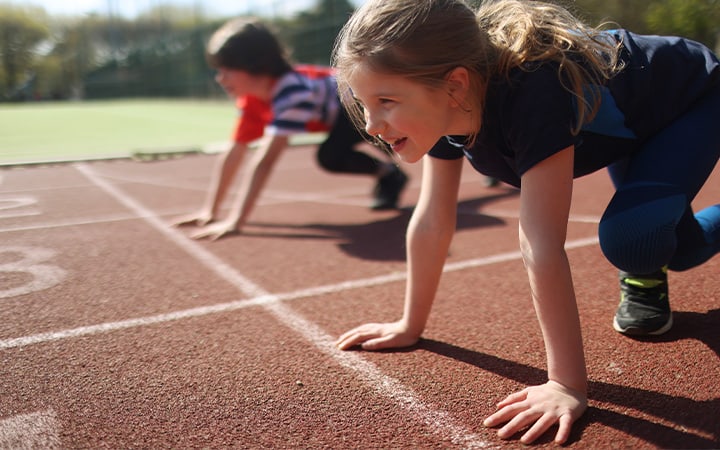Ready, Set, Safe Youth Running
September 26, 2022
 University Hospitals Rainbow Babies & Children'sExperts in Children's Health
University Hospitals Rainbow Babies & Children'sExperts in Children's Health

For young athletes motivated to do so, adding a running routine to their training can be extremely beneficial. But personal health risks or poor training increase their risk for injury.
“A running routine offers valuable training for the young athlete,” says University Hospitals sports medicine specialist Laura Goldberg, MD. “It benefits cardiovascular health, weight management, bone density, cognitive development, positive self-image and emotional well-being. But before dashing out on the track or trail, it’s important to know the essentials. The proper preparation, supervision and a focus on healthy growth and energy will help reduce the risk of injury.”
Pre-Participation Exam
Prior to any physical training, a pre-participation exam (PPE) by a primary care provider is essential. A PPE screens for health and injury risk factors.
A PPE looks for heart issues, low or high BMI, growth indicators and prior injury such as stress bone fractures. Because proper nutrition and available energy are essential to the athlete, the provider will review the child’s diet and the possibility of eating disorders or nutritional deficiencies. Eating disorders impact overall health and energy availability, and can result in complications such as arrhythmia or renal failure. A PPE also looks at menstrual function in age-appropriate girls, a primary indicator of health. Diagnosis and treatment of health risks and problems can put the athlete back on track.
If your child is given a clean bill of health, here are some other essentials to ensure training goes smoothly.
Find a Qualified Trainer/Coach
Have a qualified coach or trainer who will monitor for any health issues or injury as a new running routine progresses. The coach should know how to age-appropriately increase and vary the training to prevent injury.
Gradually Increase Intensity
Start slow and build towards more intensity. Start out walking and add intervals of running. Gradually add more and longer intervals of running. Limit the increase in distance to a maximum of 10 percent per week.
Speed, distance and terrain (such as hills) all factor into the training load put on the body when running. These should be gradually increased over time. Never increase all of them at the same time.
Break the training into segments and don’t do exactly the same route or routine all of the time.
Rest & Recover
Recovery from running is critical. Children should rest at least 1 day per week and 1-2 weeks every 3 months. They also need plenty of sleep. Kids ages 6-12 should sleep 9-12 hours a night. Kids ages 13-18 should sleep 8-10 hours a night.
Kids should take time off from running in the off-season. This provides physical relaxation and mental recovery.
Prioritize Nutrition, Hydration & Stress Management
Stay hydrated. If a child waits to drink until they’re thirsty that can be too late to prevent dehydration. Pack a water bottle or sports drink for training days. When well-hydrated, urine is light yellow. Good nutrition is also necessary to maintain adequate energy, overall healthy function and proper growth. Consult a sports medicine dietitian for an individualized plan.
Pay attention to signs of stress. Dealing with school, sport and life stress requires energy and contributes to the physical and mental load that your child experiences. Play, rest and recovery are crucial to maintaining health.
Don’t Specialize
Specialization in a single sport or training routine is not recommended due to increased injury risks and a high burnout rate. Avoid having your child play the same sport year-round. Limit participation in any one sport to less than nine months per year. Participation in multiple sports and “free play” (playing for fun outside of competition) is encouraged.
Stop Running & Seek Medical Care if Your Child Has:
- Pain that increases while running or becomes sharp
- Pain that lasts more than 24 hours after running
- Pain greater than 3 out of 10 that persists
- Pain that causes a limp
- Pain similar to a prior injury that resulted in time off from running
Relate Links
At University Hospitals Rainbow Babies & Children’s, we have a full team of sports medicine doctors dedicated to treating athletes of any age – from toddlers through adolescence and teenagers or young adults. Learn more.


